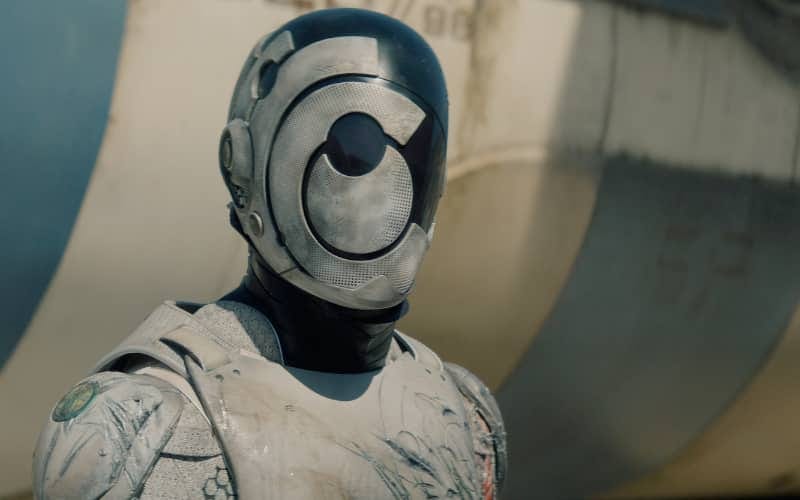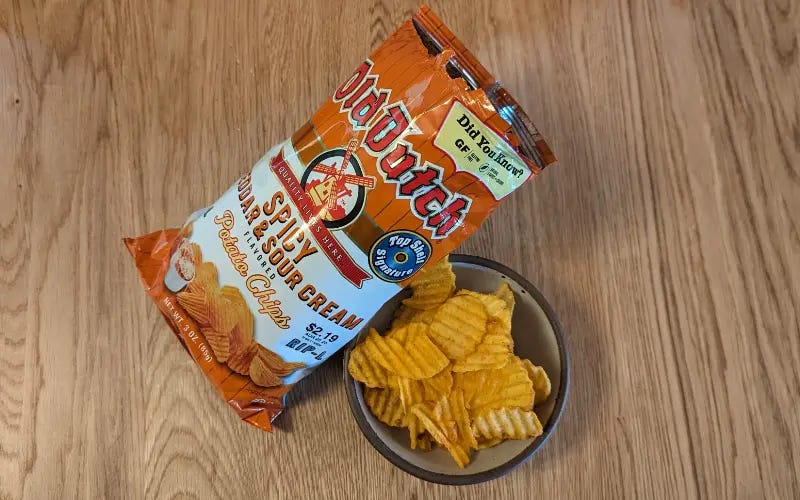Noxious weeds, coinage death, and the best way to make coffee
This is our third summer on the manor in the Middle of Nowhere, but it's still amazing how quickly the flora goes from dead and brown to lush and green. This is the time of year when people think to themselves, "Oh, yeah. This is why I live here."
But we're having some trouble with the pernicious wild parsnip, an invasive plant species that secretes a phytodermatitic sap. That means when this sap contacts skin and sunlight, it causes long-lasting burns and rashes. It's nasty stuff. (Don't search that, at least not for images of phytodermatitis. Trust me.)
And it grows in a wide variety of soils. To get rid of it you can use herbicides, keep the flowering heads from going to seed, or cutting the root below the surface and pulling it out before it produces seeds. Each plant has a two-year life-cycle, so you can mow it down to prevent seeding, too, but mowing can aerosolize the sap and, well, that can be nasty.
So every day I wander around the property and dig out piles of the noxious weed with a specialized tool. Such is the joy of land stewardship.
Let's talk about Murderbot some more
All right. So as readers of this newsletter are more than aware (painfully aware, some might say), I'm a fan of The Murderbot Diaries by Martha Wells.
As such a fan, I was tentatively looking forward to the Apple TV+ series, another fact the readers of these ramblings are more than painfully aware.
Well, we're now eight episodes into the series and, while I'm finding the show entertaining, it’s also slightly less than I'd hoped for. I have four main issues.
Short episodes. The series is scheduled for 10 episodes. But each episode is only 22 minutes. I think the idea was to emulate the serial sci-fi classics of the 1950s, like Buck Rogers and Flash Gordon. That is, short in duration with something of a cliffhanger ending.
So far, every two episodes feel like a bisected single episode. So it seems like we're really getting five 44-minute episodes spread out over 10 episodes. I feel slightly cheated by this. I would have rather had a solid five, 44-minute episodes than 10 short snippets.
Disjointed writing. The showrunners are brothers Chris & Paul Weitz. Chris wrote Rogue One. Paul wrote Nutty Professor II: The Klumps. (To be fair, Chris has a co-writing credit on The Klumps, but I'm setting up a joke here). And, so far, Murderbot feels like what you'd imagine if someone pitched you Rogue One meets The Klumps. That is, a drama-filled, high-stakes science-fiction adventure blended with ridiculous characters played primarily for comedic value. Which brings us to …
Comedic tone. The show relies quite heavily on sitcom-style humor that's not really my jam. Now there is comedy in the source material, certainly. But it's more thoughtful and significantly drier and sharper, which satisfies me more than the slapstick stylings we're getting in the series.
Weak characterization. In Wells's stories, reading the exploits and witnessing the growth of the the supporting cast is almost as fun as following SecUnit's exploits. But in the show, these characters are reduced to goofy stereotypes.
Only Ratthi feels the most true to his book character. Gurathin is developing nicely, although he’s portrayed as something of a creep in the show. Dr. Mensah, the accomplished leader of a planet-wide democracy, comes off as whiny every time she second guesses every one of her decisions.
In the book, Ping-Lee is a top-notch attorney able to write iron-clad contracts that confound the bureaucracies of the Corporation Rim. In the show she's a nervous wreck worried about the deeper implications of the polyamorous relationship between her, Arada, and Ratthi. (Yes, yes. She does draft a contract in the show, but it's only one setting the parameters of the polyamorous relationship. Hardly galaxy-shattering stuff.) And poor Arada is reduced to caricature as the middle member of this trio.
I've read a few reviews that praise the character development in the series. At first I wondered if we were watching the same show. But if you're looking at just the first novella (All Systems Red, upon which this first series is based), then I agree the secondary characters in that story aren't really fleshed out. Their characters don't develop until later in the series.
But if you have the foreknowledge of how those characters are later shaped in the source material, it would make for a stronger series to plant those seeds a little deeper in the opening season. And much earlier in the season; we don’t get any meaningful characterization of the secondary cast until episode six.
As for Alexander Skarsgård's performance, he's making it work. Except for his rugged good looks. I didn't really have a solid visual in mind for SecUnit's facial features as I read the stories, but I always imagined it to be a bit more outwardly mechanical and somewhat androgynous.
Yet despite the other characters commenting on SecUnit's handsomeness (or perhaps because of it) I find myself distracted from the storytelling by Skarsgård's outward physical appearance. But I've mostly gotten over it by episode eight.
All that said, I am enjoying the show. It's not quite what I was hoping for, but it's still an enjoyable way to spend 22 minutes at the end of a work week. So yes, I'm still looking forward to the new episodes every Friday. In fact, I'm already a little sad that it'll be coming to an end in just two short weeks.
And I do hope there's enough traction to get a season two.
The best way to make coffee
Making coffee is something of a personal preference. I recently had a conversation with a friend who swears that his "bean-to-cup" espresso machine makes the best coffee ever. (But he also swears by Kirkland Signature beans, so...)
My preferred brewing method is the pour-over. I've written about my technique in a post I've called How to Brew the Perfect Cup of Coffee Every Time (note to self: this probably needs an update).
So I was delighted when I learned that a group of researchers from the University of Pennsylvania published a paper in issue 37 of the Physics of Fluids scientific journal titled "Pour-over coffee: Mixing by a water jet impinging on a granular bed with avalanche dynamics."
Side note: This was also when I was equally delighted to learn there's a scientific journal titled Physics of Fluids that, in addition to coffee analysis, includes articles like "Phase behaviour of Cacio e Pepe sauce" and "Experimental and numerical investigation of beer foam."
Unfortunately for fans of both fluids and free information, the coffee study, co-authored by Margo Young and Ernest Park (both graduate researchers in Assistant Professor Arnold Mathijssen's lab in University of Pennsylvania's School of Arts & Sciences) is behind a paywall.
But fortunately Penn Today, an official news outlet about what's going on at the University of Pennsylvania, features an extensive write-up of the results in an article titled, "For a better cup of coffee, look to physics."
The article presents a lot of good information on coffee brewing techniques, but the emphasis is on making a rich, flavorful cup of coffee using fewer beans. Here are three key findings taken from the above linked article:
The necessity of a laminar (smooth), non-turbulent flow of water like you get from a gooseneck kettle (such as my tried-and-true Bonavita).
Pouring the water from height creates a stronger mixing effect.
Extraction of coffee can be fine-tuned by extending the mixing time with slow, more effective pours that take advantage of "avalanche dynamics."
In short, the team postulates that the flavor and strength of the finished cup of coffee can be adjusted by changes in the flow rate and increasing the height (but not too high) from which the brewing water is poured.
The implication here is that one can make the perfect cup of coffee with fewer beans. This is an important finding because the coffee plant's ideal growing regions continue to shrink even as demand for quality beans is on the rise [1].
And the study offers greater implications in erosion, dams, water filtration, wastewater treatment, and anywhere flowing water comes into contact with particulate solids.
But for me the takeaway is that there are Ph.D. candidates doing serious scientific research on the best ways to brew coffee. And that's pretty neat.
A Heavy* Mug
Along with my fondness for coffee, I have a fondness for coffee mugs. One might even call it a weakness. One way to combat feeling weak is to work out. And when you work out, all the fitness gurus say you need to lift something heavy.
So for just $79, you can get your hand on the Heavy* Mug, a liquid-holding vessel made of food-grade stainless steel that weighs five pounds and offers, in the words of the company's advertising, “gains with every sip.”
The Heavy* Mug (the asterisk is there, I presume, so the word "heavy," an otherwise non-trademarkable word, can be trademarked) has an 11.5 ounce capacity and includes a knurled handle, very much like a barbell. This feature promises a "no-slip grip," even if your palms get sweaty. Which is a weird claim. I've consumed a lot of coffee in my years, and not once has it made my palms sweaty. Perhaps I'm an outlier.
I know what you're thinking. "5 pounds? That's nothing!" But don't worry! Heavy* also sells a 22-pound mug for $220 and a few other Heavy*-branded drinking vessels, all of stainless steel with ludicrous weights and high price points.
In the nascent days of the internet, I used to write a snarky series called "Stuff You Don't Need." And the Heavy* Mug is definitely something you don't need.
Life is hard enough. Let me drink my coffee easily.
Penny Dreadful
One of the biggest news stories in recent news is that the U.S. Treasury is going to stop producing pennies.
The government placed its last order of "blanks" (that is, un-minted) pennies in May 2025 and new pennies will stop going into circulation in 2026.
For years, we've been told that cost of making a penny is more than its one-cent face value. And that seems to have been the case for the last 19 years. According to the U.S. Mint's 2024 Annual Report (that link is to a PDF; see pages 10, 12-13), each penny costs 3.69 cents to make. In 2024 alone, this resulted in a loss of 85.3 million dollars.
So what does this mean for the penny? The average life cycle of any coin is 30 years. And by the best guess of the people who make these best guesses, there are still 240 billion pennies in circulation (with an estimated 60% of that number sitting in dusty jars). That's about 720 pennies for every U.S. citizen.
So even though no more pennies will be produced, they'll still be in circulation until at least the year 2056. Maybe they'll fade away with attrition. Maybe they'll become collectible. Or maybe they'll be around for a really long time.
No matter which scenario unfolds, at some point the United States will stop using pennies. This means that maybe we can finally dispense with intentionally deceptive fiction of prices of goods ending in $0.99 — a practice that dates back to 1876 and was initially intended to prevent employees theft.
Instead, prices will (probably) be rounded to the nearest five cents. This, of course will have the unintended consequence of a higher demand for nickels. And, like the penny, the nickel costs more to make than its value. A lot more.
In the U.S. Mint Annual report linked above, we learn that each nickel runs a whopping 13.78 cents, resulting in a (2024 loss of 17.7 million).
For my money, I'd rather just jump to rounding things up to the nearest 10 cents, a move that would allow the U.S. Treasury to get a financial boost from the much more profitable dime (which costs just 5.76 cents).
From the Old Dutch Files. Episode 9.
For those of you who've been around for a while, you know I've been walking down nostalgia lane with Old Dutch, the regional chips I remember loving as a kid. They now offer many different flavors and varieties. Here's the next sampling in that chapter.
Spicy Sour Cream & Cheddar RIP-L
140 Calories and 170mg sodium per serving (10 chips)
Potatoes, canola and/or sunflower oil, whey, corn maltodextrin, contains two percent or less of: salt, cheddar cheese (cultured milk, salt, enzymes), buttermilk, nonfat milk, blue cheese (milk, salt, cultures, enzymes), spice, natural flavors, dehydrated onion, dehydrated garlic, extractives of paprika (color), extractives of annatto (color), sour cream, disodium phosphate, lactic acid, citric acid. Contains: Milk.
Another entry in the RIP-L line, this chip is nearly identical to the standard Cheddar & Sour Cream chip (profiled back in Dispatch No. 16). The only real difference in the ingredient list is the single mysterious “spice.”
And how spicy is spicy? Moderately so, but enough to make the mouth tingle if you chow down more than a few chips. Overall, a good chip, but the spice imparts a lingering aftertaste that feels somewhat artificial. So, even though I like a little heat with my chips, I can’t rate it as high as its non-spicy brand-mate.
4 stars.
This dispatch is at risk of getting too long, so to close out this issue, here's your allotted dose of Sweet James the cat.
These missives always take a little longer to put together than I’d like them to. So if you're wondering what I get up to in between issues, you can find me at Instagram and Blue Sky. And, of course, check out what's going on at the Wisconsin Explorers Guild.
As always, thanks for reading. Remember to treat yourself right and don't forget to hug someone you love.
Please know that some of the links above are affiliate links, the use of which helps me keep writing (at no additional cost to you).












